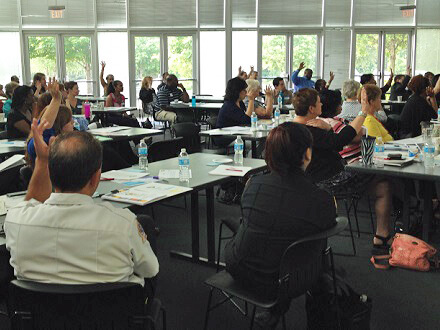 A town hall meeting is an informal public meeting around shared subjects of interest. For many years, town hall meetings have been an important tool for informing citizens about emerging issues, gauging where a community stands on a subject and identifying and implementing solutions to a problem. These meetings also serve as an avenue to get messages out to the public, generate news media coverage, jump-start local advocacy efforts by mobilizing community support and identify individuals and organizations for future collaborations.
A town hall meeting is an informal public meeting around shared subjects of interest. For many years, town hall meetings have been an important tool for informing citizens about emerging issues, gauging where a community stands on a subject and identifying and implementing solutions to a problem. These meetings also serve as an avenue to get messages out to the public, generate news media coverage, jump-start local advocacy efforts by mobilizing community support and identify individuals and organizations for future collaborations.
Youth Action Teams can implement a town hall meeting in their community to shed light on issues related to underage drinking, marijuana use, prescription drug abuse or any other issue that is pertinent. Follow these steps to get started:
STEP ONE: Form a Planning Committee
A good way to make your event as successful as possible is to form partnerships with a variety of organizations and other likely allies, and work with them to plan your event. These relationships will raise the profile of your town hall meeting and increase public awareness and attention. Your partners will also be able to help you establish the event’s credibility and secure free services such as audiovisual equipment, space or refreshments. All planning partners and supporters should be publicly recognized as sponsors of the event.
Some possible partners include your local or state agency responsible for alcohol and drug services, your state’s member of national prevention and recovery networks, community recovery organizations, treatment and recovery centers, Drug Courts, educators, youth in the community and faith-based institutions. It is recommended to have at least four people on your planning committee, including both adults and youth. It is helpful to recruit your planning committee as early as possible as they will be integral in helping plan, manage and promote the event. Sometimes, more than one committee or subcommittee may be appropriate, such as a logistics committee or media committee who can work independently and report back to the planning committee.
STEP TWO: Research the Unique Characteristics of Your Community
 Before organizing your town hall meeting, it is important to understand your community’s unique issues, challenges and opportunities for change. Review local data from a variety of sources and develop a community profile based on solid research. This information will help you know how to focus the discussion and give your program and presentations credibility. This profile should include the community’s demographics, distinct culture, political environment, history of alcohol and drug problems, opportunities for treatment and recovery support services and social and historical barriers to obtaining help.
Before organizing your town hall meeting, it is important to understand your community’s unique issues, challenges and opportunities for change. Review local data from a variety of sources and develop a community profile based on solid research. This information will help you know how to focus the discussion and give your program and presentations credibility. This profile should include the community’s demographics, distinct culture, political environment, history of alcohol and drug problems, opportunities for treatment and recovery support services and social and historical barriers to obtaining help.
STEP THREE: Identify Your Objectives
No two town hall meetings are alike. Your meeting’s content, format and objectives will depend on the particular community concerns and needs that you and your partners have identified. For example, your objective could be to inform families and residents about the problem of addiction and the need for treatment and recovery services in the community. Others may want their town hall meeting to be a forum for a call to action, such as increased services, new policies or improved community collaboration.
STEP FOUR: Determine the Format of Your Town Hall Meeting
Your format will depend on what you are trying to achieve. One of the most common formats is a briefing by a panel of three or four people and a moderator. The panel discussion typically lasts approximately 35-50 minutes, and the question and answer period usually lasts about 30 minutes. Policymakers and the general public are the primary audience for this type of town hall.
 Another format option is a policy panel. At a policy panel, the public presents their opinions to panel members, who are community leaders that receive testimony from residents. Speakers from the general public give their accounts and urge the panelists to adopt certain measures or recommendations. In this format, the policy panel can convene after the meeting and issue its findings or recommendations based on what they have learned from the public.
Another format option is a policy panel. At a policy panel, the public presents their opinions to panel members, who are community leaders that receive testimony from residents. Speakers from the general public give their accounts and urge the panelists to adopt certain measures or recommendations. In this format, the policy panel can convene after the meeting and issue its findings or recommendations based on what they have learned from the public.
A third format possibility is a media roundtable. This would typically include two to four panelists who bring different viewpoints to an issue. They have a moderated discussion designed to highlight the issue and then take questions from reporters, who are the primary audience for this format. Media roundtables can be held in a small setting such as an office conference room or a classroom.
For more information about logistics, promotion, holding your town hall meeting and what to do after the meeting is over, view this document!
